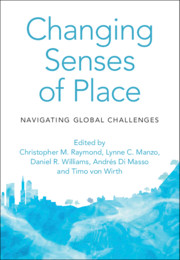Book contents
- Changing Senses of Place
- Changing Senses of Place
- Copyright page
- Dedication
- Contents
- Contributors
- Foreword
- Preface
- Acknowledgements
- Introduction
- Part I Climate Change and Ecological Regime Shifts
- Part II Migration, Mobility and Belonging
- 6 Exploring Senses of Place Through Narratives of Tourism Growth and Place Change
- 7 No One Is a Prophet at Home
- 8 Place Detachment and the Psychology of Nonbelonging
- 9 Sense of Place in Urban China
- Part III Renewable Energy Transitions
- Part IV Nationalism and Competing Territorial Claims
- Part V Urban Change
- Part VI Technological and Legal Transformations
- Part VII Design and Planning Strategies for Changing Senses of Place
- Part VIII Conclusion
- Index
- References
7 - No One Is a Prophet at Home
Mobility and Senses of Place in West Africa
from Part II - Migration, Mobility and Belonging
Published online by Cambridge University Press: 15 July 2021
- Changing Senses of Place
- Changing Senses of Place
- Copyright page
- Dedication
- Contents
- Contributors
- Foreword
- Preface
- Acknowledgements
- Introduction
- Part I Climate Change and Ecological Regime Shifts
- Part II Migration, Mobility and Belonging
- 6 Exploring Senses of Place Through Narratives of Tourism Growth and Place Change
- 7 No One Is a Prophet at Home
- 8 Place Detachment and the Psychology of Nonbelonging
- 9 Sense of Place in Urban China
- Part III Renewable Energy Transitions
- Part IV Nationalism and Competing Territorial Claims
- Part V Urban Change
- Part VI Technological and Legal Transformations
- Part VII Design and Planning Strategies for Changing Senses of Place
- Part VIII Conclusion
- Index
- References
Summary
The specific context of urban migration in West Africa provides a fertile field from which to pluralise currents concepts of sense of place. If research on sense of place is to address the global phenomena of mobility and migration, then this requires an immediate implementation of calls to consider roots and routes and fixity and flow in the production of senses of place. This chapter presents two key findings in relation to West African migrants’ sense of place, both in relation to their place of residence and their place of origin. This first is that new migrants with weak people–place bonds have a heightened quality of life in comparison to locals. This runs counter to assumptions that strong place attachment is beneficial for well-being. The second is that migrants invest considerable efforts into maintaining sense of place in locations where they no longer reside.
- Type
- Chapter
- Information
- Changing Senses of PlaceNavigating Global Challenges, pp. 92 - 102Publisher: Cambridge University PressPrint publication year: 2021

